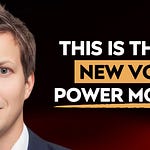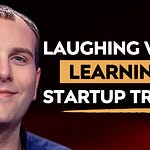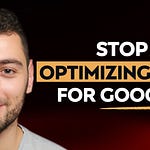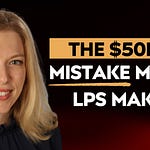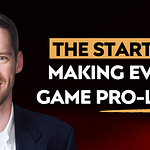Manufacturing is undergoing a massive transformation, and at the forefront of this shift is Renan Devillieres, founder and CEO of OSS Ventures. With a career that spans economics, consulting, aerospace, and startup building, Renan brings a rare perspective to one of the world’s most complex industries. His mission? To reinvent how factories operate through software, automation, and a new generation of entrepreneurs.
From Economist to Entrepreneur
Renan’s path wasn’t straightforward. After studying mathematics in France, he became an economist at the OECD before moving into consulting and eventually running factories in industries like luxury, defense, and aerospace. While successful in corporate life, he realized he had an entrepreneurial streak.
That realization led to his first startup—an AI-powered solution to better match workers with the right jobs. The company grew rapidly, raising funding through Series B, before Renan sold his shares. This exit gave him both capital and clarity: he wanted to focus on transforming manufacturing itself.
The Tesla Spark
The pivotal moment came during a visit to Tesla’s Fremont factory. Unlike traditional plants, Tesla’s operations were software-driven—from deploying code across machines to rethinking production like a computer system. For Renan, it was as if he had glimpsed the future of factories, and he couldn’t unsee it.
This experience became the inspiration for OSS Ventures, a venture studio dedicated to creating industrial startups.
Why OSS Ventures Builds Instead of Invests
Renan initially considered investing in manufacturing startups. But after analyzing more than 400 companies, he found consistent problems:
Founders lacked experience compared to peers in fintech or SaaS.
Adoption cycles were painfully slow due to regulatory and technical barriers.
Growth rates lagged far behind other industries.
Instead of waiting for world-class industrial startups to appear, Renan decided to create them himself. With his own capital, he and his team began visiting factories, identifying real pain points, and pairing those insights with capable founders.
OSS Ventures by the Numbers
In just 4.5 years, OSS has achieved impressive results:
22 startups launched, with 19 still active
11 Series A rounds closed
Collectively generating $42M ARR
Operating in 2,200 factories worldwide
This hands-on approach—combining user research, founder matching, and deep industry expertise—has proven that industrial innovation can be accelerated when done systematically.
The Future of Manufacturing
Renan sees several major trends reshaping factories today:
Automation is moving from blue-collar to white-collar roles.
While machines have long replaced physical labor, many factories still rely on office workers running Excel sheets and legacy systems. AI is now automating those workflows.Factories will become software-defined.
Like data centers, future factories will run with small teams but massive output, powered by software-driven automation.Mass production meets microfactories.
Large-scale infrastructure (like gigafactories for batteries) will coexist with small, agile factories customizing and innovating on top—similar to how smartphones support countless apps.Europe has untapped strengths.
Despite slower capital markets, Europe’s highly skilled and cost-effective engineers provide a competitive edge for finding product-market fit before scaling globally.
Lessons for Entrepreneurs
What makes a great founder in this space? Renan highlights three traits:
Trust and precision – Manufacturing leaves no room for error.
Visionary thinking – Founders must help factories imagine possibilities they can’t see themselves.
Resilience – Success requires grit, taking constant hits and persisting anyway.
OSS’s rigorous 12-week founder program reflects this philosophy, with nearly 40% of participants cut along the way. For Renan, it’s simple: if it’s not a “hell yes,” it’s a no.
Final Thoughts
Factories may not sound as glamorous as consumer apps or fintech, but the stakes are higher. Manufacturing is the fabric of society, and transforming it could unlock enormous economic and social value.
Through OSS Ventures, Renan Devillieres is proving that the combination of software, automation, and bold entrepreneurs can redefine what’s possible on the factory floor. The future of factories is not only brighter—it’s smarter, leaner, and more innovative than ever before.
👂🎧 Watch, listen, and follow on your favorite platform: https://tr.ee/S2ayrbx_fL
🙏 Join the conversation on your favorite social network: https://linktr.ee/theignitepodcast
Chapters:
00:01 – Introduction and Name Pronunciation
01:08 – Math Background and OECD Economist
02:51 – Corporate Career and Entrepreneurial Realization
05:06 – First Startup and AI Job Matching
07:50 – GDPR Challenges and Exit
09:35 – Tesla Factory Visit and Inspiration
14:12 – Mapping Startups and Launching OSS Ventures
17:57 – Bootstrapping OSS and Early Experiments
20:02 – Founder Matching and Validation Process
22:33 – OSS Ventures Results and Portfolio Growth
23:15 – Traits of Successful Industrial Founders
25:24 – Founder Selection Process and “Hell Yes or No”
32:13 – AI, Automation, and Factory Transformation
36:18 – Dark Factories and Software-Defined Manufacturing
40:08 – Europe’s Role in Industrial Innovation
42:13 – Software Bottlenecks in Industry 4.0
44:52 – The Future of Supply Chains and Microfactories
Transcript
Renan Devillieres (00:00:00): Creating a humanoid robot, every single mechanical thing has been solved. Every single one. So now it's software.
Brian Bell (00:00:06): That's really interesting. So basically, you can automate the manufacturing with robotics already. It's just software that's the bottleneck.
Renan Devillieres (00:00:13): Yeah, and actually, it is software. And even more than that, it is the cost of software. Because give me any task, give me 10 million bucks, and I automate the task for you. Any task. The thing is...Very, very few processes in manufacturing can justify such a high level of automation. And the secret is that you now have like 50K robots, 25K robots. But the cost of programming, being a human doing the thing, having a human understand the concept, doing so that the concept is rigid, having always the same thing at the same place, being automated in the same way and everything. The cost of that is so high that a lot of things have not been automated.
Brian Bell (00:01:19): Hey, everyone. Welcome back to the Ignite podcast.Today, we're thrilled to have Renan on the program. He's the CEO and founder of OSS Ventures. Thanks for coming on.
Renan Devillieres (00:01:28): Thanks for having me.
Brian Bell (00:01:29): Well, the first thing that we'd love to learn is how to say your name. And we were kind of giggling about this before we started recording. Maybe you could, for us Americans out here,maybe you could tell us how to say your name like a French person.So if you're in France,
Renan Devillieres (00:01:42): You say Renan, and anywhere else in the world, basically, you say Renan.
Brian Bell (00:01:45): You know, my son's actually taking French in high school right now. And I asked him, I was like, oh, okay, that's interesting. Why are you taking French? He goes, oh, because no one else is.It's not a normie language, is what he called it. Like, everybody in his high school is taking Spanish because it's California, and he wanted to differentiate himself. And he's really into math, too. And the French obviously have a long history there, but.Maybe you could walk us through your background, your origin story and how you got to be doing what you're doing.
Renan Devillieres (00:02:12): Sure. I was good at math. So in France, when you're good at math, the state pays for your school. And so the state paid for my studies. I was like one of the best math school in France. And then like one week before finishing my studies, I learned through France because I wasn't going to the courses. that I had either to repay what the state had given me or I had to become a public servant. So I googled highest paid public servant France and I ended up with being an economist at the OECD, a specialized in industry. And I did that for two years and one day to repay my debts. After that, I worked in consulting.
Brian Bell (00:02:53): Basically, forced labor. You had to go be an economist for the government. Yes, exactly.
Renan Devillieres (00:02:59): I didn't know about it. Yeah. And so I did that for two years and one day. Then I became a consultant specializing in manufacturing and operations. Became a factory director. I worked in a luxury defense aerospace. And after 10 years of corporate life, I realized that there was a pattern. And the pattern was I was given a new job and then people will threaten to fire me. And then I would overperform and I would get promoted to another job. nd the cycle would like again and again and again. It was like, that's an interesting pattern. And I realized I was an entrepreneur.
Brian Bell (00:03:35): I've had the same experience in corporate life. Exactly.
Renan Devillieres (00:03:38): Oh, yeah.
Brian Bell (00:03:39): You get in and you're outperforming everybody around you and you threaten the status quo.
Brian Bell (00:03:43): Yes. Right. Because you're working hard. You know, my story was I worked for Boeing out of college in finance and I was also good at math. Probably not as good as you. But, you know, so I got a finance degree and, you know, I worked full time in college. you know, poor kid, whatever. But, you know, I got to Boeing and I'd get my whole week's worth of work done in two hours. And I've said, I've told this story on the podcast. So any longtime listeners are like, all right, rolling their eyes right now. But, you know, the guy next to me would be like, hey, why don't you slow down a little bit? Yeah. And I'm like, why would I slow down? I got all the work done. And are there any errors in the work? And he goes, no, it's perfect. But we kind of take our time around here. And that always stuck with me.
Renan Devillieres (00:04:26): Someone told me, “You’re way too intense. Stop caring so much.” And I’m thinking: I’m going to spend 75% of my waking time not caring? What?
Brian Bell (00:04:39): It’s like that show Severance on Apple.
Renan Devillieres (00:04:43): Exactly.
Brian Bell (00:04:44): People want to separate work from life. Entrepreneurs can’t. That’s cognitive dissonance. My wife and I used to fight because I wasn’t fulfilled at work. I’m like, “Work should be fulfilling. You spend half your waking hours on it.” She goes, “Stop trying to find fulfillment from work.” I said no, kept iterating, found my way to startups and venture capital. If I hadn’t kept iterating, I’d be sitting at Boeing, miserable.
Renan Devillieres (00:05:22): Doing Excel spreadsheets, getting automated by AI.
Brian Bell (00:05:27): Right. So you realize you’re an entrepreneur. Then what?
Renan Devillieres (00:05:32): I quit and looked for what to do. I had unique exposure to an interesting issue: recruiting people who are very bad at writing their CVs. As a factory director, I’d hired hundreds of low-skill students. Some were awesome; some were awful. The “10x engineer” exists in the blue-collar world too. I decided to leverage AI to put the right people in the right roles. It’s an allocation problem: if you love talking to people but have no qualifications, you might love the hotel front desk and hate a warehouse; if you love details and don’t like talking to people, you’ll love the warehouse and hate the front desk. So I used AI for that. We found product–market fit in about a year and a half. I moved to San Francisco and Brazil. We moved our primary market to Brazil because GDPR made our business illegal in Europe—you can’t hire someone purely by an algorithm. That’s the law. They like to make laws about everything. We did seed, Series A, Series B. I sold my share at Series B. I’m not from money, so suddenly having money, I asked, “What now?” I visited the Tesla factory in the Bay Area and thought, “I want to spend the next 10 years doing this to all factories in the world.” That was the aha. Then I started Oasis. That’s the origin story.
Brian Bell (00:07:57): A lot to unpack. So you’re at a startup, scaling to Series B, and there’s a discussion with the board—maybe time for a professional CEO or time for you to leave. Tell us about that transition.
Renan Devillieres (00:08:11): I was CPTO; the CEO was another co-founder. I managed tech and product. In one meeting a backend engineer discussed server costs—four sprints to save 8%. I thought, “I’m firing myself.” It wasn’t zero to one anymore. It wasn’t fun—more like nine to ten, ten to eleven, grinding small efficiencies. I’d written the first Jupyter notebook for the company two years prior. I wasn’t doing that. So I fired myself, became the product guy. Then Series B was about scaling to 120 people, adding process. Not me. We made a deal; I sold half my shares, kept the other half. It was a windfall—and scary, unknown territory, not having to grind every second.
Brian Bell (00:09:24): Amazing. What spurred the Tesla factory trip? Not everyone can just go look around.
Renan Devillieres (00:09:32): After I sold, I was pacing the living room making calls. My wife said, “Get a WeWork or one of us will go crazy.” So at WeWork, I made calls to friends—“What are you up to?”—coding, talking to people who’d made money—“What do you do with your days?” A friend at Tesla said, “You know manufacturing. Come visit.” They had a program for outsiders then. It was just before production hell—before they put the tents in the parking lot.
Brian Bell (00:10:14): So around 2018 when the Model 3 rolled out?
Renan Devillieres (00:10:19): I exited beginning of ’19, so yes. By then I’d visited hundreds of factories. This was the first factory that felt like… imagine someone seeing the first water mill when none existed in his region. That level of difference. I thought, “This is my thing. I need to do this now.”
Brian Bell (00:10:43): Was it the automation level? The efficiency?
Renan Devillieres (00:10:51): It was wildly inefficient, actually—but the factory was thought like a computer, and the people were tech/data/computer profiles. All the ratios were off. In most physical goods, for every $100, you buy about $4 of software—ERP and such. At Tesla, it was something like $20. Everything was software. Different people, different thinking. For example, in every factory I’d seen, you write code and physically push it to a machine—USB stick. Tesla had continuous deployment pushing code to tens of machines at once. Common in tech, unheard of in manufacturing. If you have the same machines across factories, two coders could push code to hundreds of machines. This wasn’t happening anywhere.
Brian Bell (00:12:26): People didn’t think holistically; it was line-driven—each line run its own way, serialized steps.
Renan Devillieres (00:12:41): Exactly. Very computer-like continuous improvement: leverage per dollar spent—basic CS concepts missing for years in manufacturing. It blew me away—I couldn’t sleep for two days.
Brian Bell (00:12:59): So what did you do next?
Renan Devillieres (00:13:06): Simple plan. My wife wanted to go back to Europe. I had some money; I’d become an investor in tech for manufacturing. So I did what any nerd does: wrote a crawler; found ~450 startups in factory software in Europe and the US. I called them all.
Brian Bell (00:13:30): 450 startups?
Renan Devillieres (00:13:31): Yes. I made a list and called them, saying I wanted to invest. Three realizations: (1) The average founder quality was low—worse than fintech founders. (2) These companies were slow to first dollars; to operate in a factory you must integrate ERPs and clear cybersecurity—high starting barriers. (3) Even with PMF, growth was slow. After 2–3 months I thought: I’d be a first-check investor in an asset class with only ~450 targets, slow cycles, weaker founders, and limited scaling. Maybe not the plan.
Renan Devillieres (00:14:49): I called a bunch of my smartest friends. One said: there’s a space where you can create massive value; it’s many companies, not one; you don’t buy the SAP thesis. So instead of investing in companies that don’t exist or don’t scale, create them. Become a serial company-creation guy. That’s how we launched OSS Ventures four and a half years ago.
Brian Bell (00:15:23): That’s the harder path. What does OSS stand for?
Renan Devillieres (00:15:26): Operation Startup Studio. Very simple.
Brian Bell (00:15:32): So a venture studio. You realized you can’t just go pick world-class founders from a European YC-for-manufacturing—it doesn’t exist—so you’d incubate and grow them. What next—form a fund, fundraise, or use your own money?
Renan Devillieres (00:16:06): The first two years were my own money. I told my wife: we’ll buy the apartment, you’ll be fine, but I want to reinvest a significant portion to create something never done before in an asset class that historically sucks. She said go for it. So I decided: do it for two years and see. I called factories: “I’m a retiree of the startup game; I’ll visit your factory, find pain points, and write a report on everything that could be better—free. If we find a pain point we want to work on, we launch a company.” About 40% said yes—good traction. I visited 10 factories, found two pain points, found four entrepreneurs to launch two ventures, created both. One closed, the other just raised a large round last month; they’re ~100 people, >$10M in sales, live in ~600 factories.
Brian Bell (00:17:32): So you went boots-on-the-ground, found problems, and paired entrepreneurs to build solutions. How did you systematize validation at scale—and founder matching?
Renan Devillieres (00:17:50): On ideas: we’ve since visited 860 factories worldwide and built a database with 14,000+ hours of user research. We’re 20 people now. Quarterly, we run an LLM over the data to surface new issues, new enabling tech, and willingness to pay. When we decide to launch, we already have 5–10 early adopters validated. Each week my team visits 1–3 factories, talks for eight hours, logs everything; every quarter new themes emerge. On founder matching: 70% of our founders are second-time founders. We pair one technical and one non-technical. They share the thesis—operations, reshoring, etc. We’re upfront: we’ll work together for 12 weeks to try to create the company. After 12 weeks, there’s a 40% chance we say we don’t want to continue. That 40% has been steady for ~18 months.
Brian Bell (00:19:22): So a bit less than half reach the end of 12 weeks and it’s not a fit, and you restart.
Renan Devillieres (00:19:32): Yes. We have a process, but at the end of the day it’s either a “hell yes” or it’s no.
Brian Bell (00:19:49): Same here: if it’s not a hell yes, it’s a hell no.
Renan Devillieres (00:19:57): Some numbers: we started 22 companies; 19 are live; 11 did a Series A. Collectively a little over $42M ARR across 2,200 factories in 4.5 years.
Brian Bell (00:20:18): Great impact. What have you learned about selecting founders who succeed in this market?
Renan Devillieres (00:20:28): There are “right to play” traits. You’re dealing with manufacturing—the fabric of society—so there’s no room for error or approximation. You must convince a factory director you’re that kind of person, then deliver. Obsession with technology, doing things right, being trustworthy—table stakes. I say manufacturing software is golf: if you mess up one hole, you’re done—little room for approximation. Another trait: challenger sales—challenging how the buyer thinks. Manufacturers won’t come saying, “I need this exact thing with this brand of AI.” They don’t have those skills. The founder must dream for them—more ambition than the buyer’s quotas—while staying trustworthy. And then insane grit: taking hits all day and smiling.
Brian Bell (00:21:47): How do you screen for that in interviews? You do the 12-week build, but before term sheets—how much time and what’s the process?
Renan Devillieres (00:22:05): Four-step process. Last year we had ~800 serious applicants—lots to sort. Each step tests different facets; ~20% drop rate per step—brutal. Non-technical founders do a case study—the startup they’ll build—with provocative questions: “What’s your number? When would you stop working? How big is a win to you?” We do many reference calls—5 to 10 at the final stage. And still we get it wrong 40% of the time—humbling.
Brian Bell (00:23:00): Do you want that 40% to drop over time, or is that just the cost of entrepreneurship being hard?
Renan Devillieres (00:23:14): Good question. I’m not sure it should be 20 or 80. I know it must be non-zero and non-100. Founder caliber has skyrocketed; recent cohorts often have $10M+ exits and traits we didn’t see early on. We still iterate twice a year. No definitive answer.
Brian Bell (00:23:57): After 225 investments, I’ve noticed my best ones were easy, fast yeses. The marginal ones—where I explained away a red or yellow flag—underperformed.
Renan Devillieres (00:24:51): Same. Think “Thinking, Fast and Slow”—System 1 vs. System 2. Tennis players often know the point outcome the moment they hit the ball.
Brian Bell (00:25:08): Basketball’s the same—you know as it leaves your fingertips. Investing can feel like that. Steph Curry knows and turns away.
Renan Devillieres (00:25:28): For us, by weeks 4–6 we often know. We say 12 weeks, but sometimes we end at six. Most of the time, if we say yes at 12, we knew at six—after six weeks in the trenches.
Brian Bell (00:25:50): Same for early-stage investing—I still do diligence, but it’s mostly to check for flags.
Renan Devillieres (00:26:27): What’s incredible with OSS: being young, taking many shots at the same vision. Best job in the world. In my first company I was very stressed—felt like one shot. It worked out, but now we start four companies a year. Intensity and iteration speed are up; all our companies move faster than my first. There’s a zen to it now. Our fund is up a lot since the beginning, so we have time; the opportunity is massive. Urgency, but grounded.
Brian Bell (00:27:39): How’s AI and automation adoption actually playing out on the factory floor? Where’s traction and opportunity?
Renan Devillieres (00:27:54): Three things. (1) Automation’s coming for white-collar, not blue-collar. In the ’80s a typical factory had ~700 people—~150 white-collar, rest blue. Today: ~200 people—~100 blue-collar operating many machines, outputting 2× production, plus a lot of white-collar on Excel and antiquated software. AI and agents are automating white-collar. One portfolio company’s client is going from ~80 to ~10 industrialization engineers for the same output. A luxury client aims for 80% productivity gain in supply chain. Those are the magnitudes. (2) Budgets are polarizing: typical factory does 2–3 projects a year, but big ones—80% supply chain productivity, 50% quality management. Fewer bets, higher gains. (3) About a third of projects make it. Those that do are never fully automated. You go from 80 supply-chain pros with Excel to five data scientists with agents; those five monitor, set rules, ensure the system works, debug when needed. So it’s never zero humans. We see you must design for jobs that don’t yet exist—e.g., data scientists in supply chain—and help create those roles. Work with bold innovators. Adoption cycle: 3–5 years. Gains will be immense—mostly on the white-collar side. Hidden secret: many factories in China can be reshored if we lighten white-collar cost structures.
Brian Bell (00:30:27): I saw the Wall Street Journal’s “dark factories” video. Are you seeing the same in Europe—fully reimagined, extremely automated factories?
Renan Devillieres (00:30:51): There’s lots of innovation in extreme automation. Dark factories are the extreme. We think cost structures will stabilize with very few people and lots of leverage.
Brian Bell (00:31:10): So in 5–10 years factories are basically dark—one business person and one robotics engineer walking around?
Renan Devillieres (00:31:19): We think many factories will look like data centers: 30–50 people generating immense value. To do that, you must control the software that runs your factory—it’s software-defined. Most factories are not software-defined—almost none. The big shift coming is software-defined automation.
Brian Bell (00:31:51): Do future factories run on open source so they can fork and PR, or on centralized ERP-style systems?
Renan Devillieres (00:32:05): The big unknown is standards. The web runs on TCP/IP; marketing converged on schema.org—standard names and interoperability. None of that exists in manufacturing. Key question: what happens there? Some push Unified Namespace (UNS). Today, SAP and Dassault dominate partly by making their data hard to work with at scale—obscured data structures. Dassault’s CPO has said norms—not startups or AI—are the biggest threat. My guess: hyperscalers (AWS, Azure, GCP) will tire of manufacturing being tiny and collaborate on an open-source data schema. If that happens, incredible things follow. Alternatively, an SAP/Dassault-type could go the Salesforce route and force a whole industry into a shared model. I don’t see status quo lasting 5–10 years—the pressure’s too high.
Brian Bell (00:33:45): Europe isn’t known for industrial startup velocity. What’s misunderstood?
Renan Devillieres (00:33:52): Engineers are strong and cost one-third of US engineers. Our strategy: find PMF in Europe, then go to the US. US critiques of Europe are mostly true: legal framework is a nightmare; things are slow; capital exists but is fearful—few big bets; no IPO market; weak exit market. But engineering is good because of lower living standards. So: get PMF in Europe, then become a US company. Of our ~20 companies, three already set up main offices in the US. It’s like Israel in cybersecurity: find PMF locally, then go to the US. Any ambitious European founder should consider that path.
Brian Bell (00:35:02): Comparative advantage: win a smaller market, then take it to the bigger one. What about software-led vs. hardware-integrated approaches in industrial?
Renan Devillieres (00:35:18): The bottleneck is mainly software. Example: Tesla’s gigacasting—the car’s hull in one go, no human touch—works because of ~300 IoT sensors and AI, not a new press. In the past five years, real gains came from deep-science materials and software. For humanoid robots, every mechanical problem is solved; now it’s software.
Brian Bell (00:35:56): So you can automate with robotics already; software is the bottleneck.
Renan Devillieres (00:36:03): Yes—and even more, it’s the cost of software. Give me any task and $10M, and I’ll automate it. Any task. Very few processes justify that level of spend. You might have 25–50K robots, but programming cost—humans doing the work, understanding the context, making the process rigid and repeatable—is so high that much remains unautomated. If the cost per line of code and/or contextual understanding drops by 10–100×, incredible things happen in automation.
Brian Bell (00:36:58): I didn’t realize that. With cheaper, better robotics and AI code-gen tools 10×-ing software development, you get multiple orders of magnitude over 5–10 years—big implications. Does that drive onshoring and micro-manufacturing—smaller, cheaper automation for smaller runs?
Renan Devillieres (00:37:52): In 5–10 years the supply chain will look more like smartphones than doors. Your smartphone: maybe 20 models matter, 95% of the market, mass-produced in gigantic factories with unheard-of care; then local indie devs build apps for last-mile value. For doors: small factories, low margin, little innovation, low personalization. I think most physical goods will have a base layer of enormous factories—like infrastructure—and a layer of incredibly agile micro-companies doing anything you want on top. Electrification shows this: batteries from gigafactories; what you put on top can come from micro-factories with infinite personalization. It’s already happening in China with LSEVs (low-speed electric vehicles)—there are more LSEVs than regular EVs, and people go crazy with designs. But the batteries are the same building blocks—one cell, four cells, 75 kWh packs—it’s all the same foundation. So maybe three gigafactories make batteries and 2,000 micro-factories compete on end design.
Brian Bell (00:40:10): That’s the application layer of manufacturing. Rapid fire to close: Most underrated startup in your portfolio?
Renan Devillieres (00:40:21): Vitesse Automation—no-code and vibe-coding for robots.
Brian Bell (00:40:28): One industrial SaaS idea you’re surprised nobody’s built?
Renan Devillieres (00:40:32): Workforce planning for blue-collar.
Brian Bell (00:40:35): A factory tool or workflow you never want to use again?
Renan Devillieres (00:40:38): SAP—the whole world of it.
Brian Bell (00:40:41): Hardest part of recruiting technical founders for industrial startups?
Renan Devillieres (00:40:44): Finding crafty people who won’t over-engineer on day one with microservices, Docker, etc.
Brian Bell (00:40:53): Next hub for your venture studio?
Renan Devillieres (00:40:57): Boston—we just opened the Boston bureau two weeks ago.
Brian Bell (00:41:04): Most overhyped industrial trend of the last 12 months?
Renan Devillieres (00:41:11): Food with insects—putting insects into pet food or human food.
Brian Bell (00:41:23): Most under-hyped trend?
Renan Devillieres (00:41:31): Nuclear energy.
Brian Bell (00:41:32): How long until fully autonomous factories are viable at scale?
Renan Devillieres (00:41:44): About five years.
Brian Bell (00:41:45): One lesson from Richmond or McKinsey you use daily?
Renan Devillieres (00:41:49): Always align left.
Brian Bell (00:41:51): Meaning?
Renan Devillieres (00:41:53): On slides, align all bullet points left—critical for visual management.
Brian Bell (00:41:58): If you had to replace OSS Ventures with an AI agent, what would you do first?
Renan Devillieres (00:42:03): Feed it all our user research from the last four–five years—full context.
Brian Bell (00:42:10): I often wonder when VCs get replaced by agents. If you weren’t building OSS, what would you do?
Renan Devillieres (00:42:20): A venture to let people vote without the Senate and people in charge—direct democracy via bottom-up consensus.
Brian Bell (00:42:31): The US uses representative government because the Founders feared “the temper of the masses.” How do you square that with direct democracy?
Renan Devillieres (00:43:04): Short term, the masses can take bad decisions—anger, impulses. Long term, you can change constitutions—change the rules. So constrain short-term changes; allow larger changes only with sustained consensus over time. Granularity, timing, subject scope—those matter.
Brian Bell (00:43:48): Yeah. Political economy is fascinating. Thanks for coming on. Where can folks find you?
Renan Devillieres (00:44:18): OSS.Ventures. I’m active on Twitter. Contact us if you’re an exited founder thinking, “Maybe I should set foot in a factory,” or an industrialist wanting us to visit—yes, we can come for free. Anyone interested in making operations work a bit better for everyone—reach out.
Brian Bell (00:44:45): Thanks so much. Great convo.
Renan Devillieres (00:44:46): Thank you, Brian.




